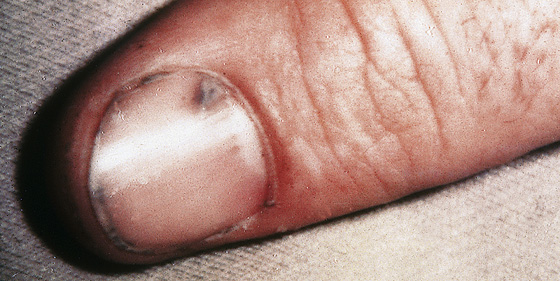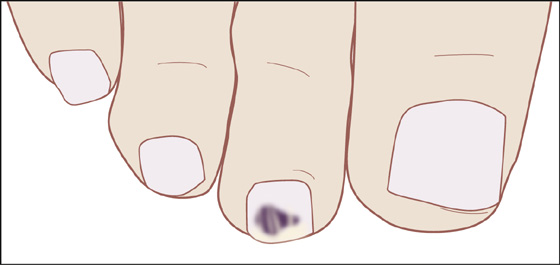CHAPTER 155
Subungual Ecchymosis
(Tennis Toe)
Presentation
The patient had a crushing injury over the fingernail after getting it caught between two heavy objects (i.e., car door or door jamb) or striking it with a heavy object, such as a hammer. The pain is initially intense but rapidly subsides over the first half hour. By the time the patient is examined, only mild pain and sensitivity remains. There is a light brown or light blue-brown discoloration beneath the nail (Figure 155-1). A similar but painless condition can occur with repeated minor trauma to a toenail, which can occur inside a sport shoe when rapid thrusting of the athlete’s toes into the toe box occurs as a result of abrupt stops, such as on a tennis or basketball court (“tennis toe”) (Figure 155-2).

Figure 155-1 Subungual ecchymosis.

Figure 155-2 Transverse black-brown discoloration of second toenail. (Adapted from Adams BB: Jogger’s toenail. J Am Acad Dermatol 48[Suppl 5]:S58-S59, 2003.)
What To Do:
 With any significant trauma, obtain a radiograph to rule out a possible fracture of the distal phalangeal tuft.
With any significant trauma, obtain a radiograph to rule out a possible fracture of the distal phalangeal tuft.
 With traumatic ecchymosis, if there is continued painful sensitivity, apply a protective fingertip splint.
With traumatic ecchymosis, if there is continued painful sensitivity, apply a protective fingertip splint.
 Many patients are expecting nail trephination after experiencing a previous subungual hematoma (see Chapter 156). Therefore it is often helpful to explain to the patient that you are not drilling a hole in the nail. Tell him that there is not enough blood under the nail for the procedure to improve discomfort and that it could actually do harm and might even be very painful.
Many patients are expecting nail trephination after experiencing a previous subungual hematoma (see Chapter 156). Therefore it is often helpful to explain to the patient that you are not drilling a hole in the nail. Tell him that there is not enough blood under the nail for the procedure to improve discomfort and that it could actually do harm and might even be very painful.
 Inform the patient with a larger injury that, in time, he may lose the fingernail (or toenail) but that a new nail will replace it.
Inform the patient with a larger injury that, in time, he may lose the fingernail (or toenail) but that a new nail will replace it.
 Tennis or “jogger’s” toe resolves with or without treatment. Tennis players and runners need to wear properly fitting sport shoes that have an adequate toe box that does not allow the most distal toe to slam into the end of the shoe. The patient should also be informed that improperly cut nails can allow the same type of trauma to occur.
Tennis or “jogger’s” toe resolves with or without treatment. Tennis players and runners need to wear properly fitting sport shoes that have an adequate toe box that does not allow the most distal toe to slam into the end of the shoe. The patient should also be informed that improperly cut nails can allow the same type of trauma to occur.
What Not To Do:
 Do not perform trephination of the nail.
Do not perform trephination of the nail.
Discussion
Unlike the painful space-occupying subungual hematoma, the subungual ecchymosis represents only a thin extravasation of blood beneath the nail or a mild separation of the nail plate from the nail bed. Trephination will not relieve any pressure or pain and may indeed cause excruciating pain, as well as opening this space to possible infection. The patient’s familiarity with nail trephination (as noted) may give him the erroneous expectation that he should have his nail drilled.
Bear in mind that not all dark patches under the nail are subungual hematomas. Diagnoses such as malignant melanoma, Kaposi sarcoma, and splinter hemorrhages (often associated with infective endocarditis) should be considered when the history of trauma and the physical examination are not consistent with a simple subungual hemorrhage.

Full access? Get Clinical Tree


